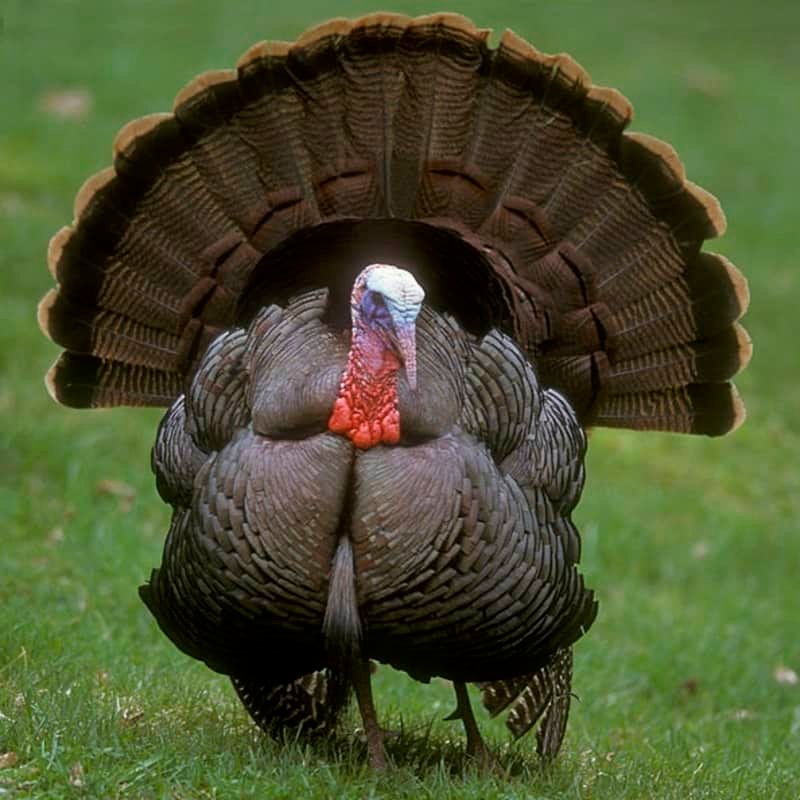The wild turkey (Meleagris gallopavo) is the biggest member of the order Galliformes and one of two extant turkey species. It is the progenitor of the domestic turkey, which came from a wild turkey subspecies from southern Mexico (not the related ocellated turkey). The turkey gained its name from the domesticated type transported to Britain via Spain from the Levant. The British then identified the wild turkey with Turkey, and the name stuck. [2] [3] [4] An alternate explanation holds that English colonists with knowledge of the prior species used the word to refer to the New World bird.
Quick Overview: Meleagris Gallopavo – Wild Turkey
Body size: Around 37-46 in (94-117 cm) and weight of 111986 g (395.07.99 oz)
Main colors: Black, Brown, White, Red, Pink, Pink-gray, Silver-gray, Blue
Range: Throughout the United States
Migratory Bird: No
Best time of the year to see in the U.S.: All Year (January – December)
Conservation Status: Least Concern
Wild Turkey Description
Wild turkeys have long legs, long necks, and huge fan-shaped tails. Their wings are rounded. Men have dark iridescent plumage. Their wings are black with brown stripes and white bars. They have a red wattle, a caruncle (a wart-like protrusion of skin on the upper region of the forehead), and a blackish breast tuft. Their pink, pinkish-gray, or silver-gray legs contain 3.2-centimeter spurs. Adult males (gobblers) have red, blue, or whiteheads according to the season.

Size
These birds have a length of 37-46 in (94-117 cm) and weight of 111986 g (395.07.99 oz). Their wings could range from 48-60 in (122-150 cm).
Feeding
All-food wild turkeys consume acorns, nuts, seeds, buds, leaves, and fern fronds. They ingest roughly 10% of their food as ground-dwelling invertebrates and salamanders. In order to access fruits and buds, wild turkeys climb bushes and low trees. Most foraging happens 2–3 hours before sunrise and after nightfall.
Habitat
Ruffed Grouses prefer wooded habitats in harsh, cold environments. It also favors dark, calm woodlands, dense thickets, and protected wetlands. The Ruffed Grouse dislikes wide fields and is never, if ever, seen in them.
Behavior
The Ruffed Grouse is a bird that is particularly protective of its young. The mother looks after the hatchlings until they are able to roost on trees on their own. Except during breeding season, when they cluster, these birds are usually solitary. Any woods person is certainly aware of the male grouse’s odd behavior, though few have actually observed it. A unique drumming sound is produced by the male.
Meleagris Gallopavo Scientific Classification
- Kingdom: Animalia
- Phylum: Chordata
- Subphylum: Chelicerata
- Class: Aves
- Order: Galliformes
- Family: Phasianidae
- Genus: Meleagris
- Species: Meleagris Gallopavo
Best time of the year to see
In the United States, the best time of year to see these birds is all year round, regardless of the season. This refers to any month of the year between January and December.
Distribution of the Wild turkey in the USA
They may be found throughout much of the eastern United States, as well as in isolated places in the western United States. They may also be found in northern Mexico, notably in the Sierra Nevada highlands. Germany and New Zealand have both had wild turkey introductions.
The wild turkey can be found in the following states in the United States – Alabama, Alaska, Arizona, Arkansas, California, Colorado, Connecticut, Delaware, Florida, Georgia, Hawaii, Idaho, Illinois, Indiana, Iowa, Kansas, Kentucky, Louisiana, Maine, Maryland, Massachusetts, Michigan, Minnesota, Mississippi, Missouri, Montana, Nebraska, Nevada, New Hampshire, New Jersey, New Mexico, New York, North Carolina, North Dakota, Ohio, Oklahoma, Oregon, Pennsylvania, Rhode Island, South Carolina, South Dakota, Tennessee, Texas, Utah, Vermont, Virginia, Washington, West Virginia, Wisconsin, and Wyoming.

